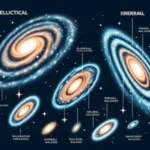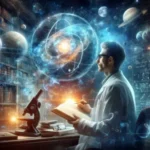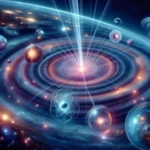From the mesmerizing glow of distant galaxies to the enigmatic whispers of cosmic microwaves, the universe has always captivated the human imagination.
At the heart of our quest to understand the cosmos lies the Big Bang Theory, a groundbreaking explanation that suggests our universe began as an infinitely small point, exploding into existence approximately 13.8 billion years ago. This revolutionary concept not only reshapes our understanding of space and time but also invites us to ponder profound questions about our origins and the nature of reality itself. In this blog post, we will delve into the compelling evidence that supports the Big Bang Theory, exploring the intricate tapestry of cosmic background radiation, the abundance of light elements, and the expansion of the universe—all while uncovering how these pieces of the cosmic puzzle interconnect to paint a vivid picture of our universe’s birth and evolution. Join us on this astronomical journey as we unveil the mysteries of the cosmos and the science that propels our understanding of the universe forward.
1. Introduction to the Big Bang Theory
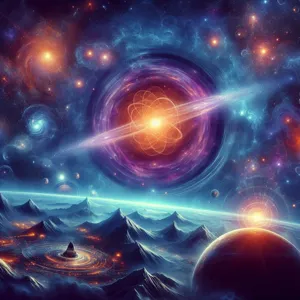
The Big Bang Theory stands as one of the most profound and transformative ideas in modern cosmology, profoundly altering our understanding of the universe and its origins. At its core, the theory posits that the universe began as an infinitely hot and dense singularity around 13.8 billion years ago, subsequently expanding and cooling over time to form the cosmos we observe today. This revolutionary concept not only provides a framework for understanding the formation of galaxies, stars, and planets but also serves as a cornerstone for exploring the fundamental laws of physics.
Imagine a balloon being inflated; this simple analogy captures the essence of the Big Bang. As the balloon expands, every point on its surface moves away from every other point, illustrating how galaxies drift apart in our ever-expanding universe. This expansion is not merely a local phenomenon but a universal one, suggesting that all matter and energy were once contained in a single, incredibly dense point before the universe began its majestic journey of growth.
Key pieces of evidence bolster this theory, including the cosmic microwave background radiation—a faint glow left over from the initial explosion—and the observed redshift of distant galaxies, which indicates that the universe is still expanding. These discoveries provide a compelling narrative of cosmic evolution, revealing how the universe has transformed from its primordial state into the complex and diverse expanse we observe today.
As we delve deeper into the intricacies of the Big Bang Theory, we will explore the evidence that supports this groundbreaking model, the scientific principles behind it, and the profound implications it holds for our understanding of existence itself. Join us as we unveil the cosmos and embark on a journey through time and space, tracing the origins of everything we know.
2. The Origins of the Universe: A Brief Historical Perspective
To truly appreciate the significance of the Big Bang Theory, it is essential to explore the historical context from which it emerged. The quest to understand the origins of the universe has fascinated humanity for centuries, with ancient civilizations weaving rich mythologies and cosmologies to explain their observations of the night sky. In many cultures, the cosmos was seen as a reflection of divine order, with celestial bodies playing pivotal roles in the rhythms of life on Earth.
However, it wasn’t until the early 20th century that scientific inquiry began to reshape our understanding. The foundations were laid by pioneers like Albert Einstein, whose theory of general relativity in 1915 reshaped the perception of gravity and the fabric of space-time. This breakthrough opened the door to a new understanding of the universe as a dynamic entity rather than a static backdrop.
In 1927, Belgian priest and physicist Georges Lemaître proposed what he called the “hypothesis of the primeval atom,” suggesting that the universe began from a single, incredibly dense point and has been expanding ever since. His ideas, though initially met with skepticism, gained traction as they aligned with emerging astronomical observations.
The 1929 discovery by Edwin Hubble that galaxies are moving away from us, leading to the formulation of Hubble’s Law, provided compelling evidence for an expanding universe. This observation lent credence to Lemaître’s theory and marked a pivotal moment in cosmology, suggesting that the universe had a beginning—a notion that was as revolutionary as it was profound.
As technology advanced, so did our exploration of the cosmos. The mid-20th century saw the discovery of cosmic microwave background radiation (CMB) by Arno Penzias and Robert Wilson in 1965, a remnant of the early universe that provided a crucial piece of evidence supporting the Big Bang Theory. This faint glow, uniformly present in all directions, suggested that the universe was once hot and dense, aligning seamlessly with the predictions of the Big Bang model.
With each scientific breakthrough, our understanding of the universe’s origins deepened, painting a picture of a cosmos that is not only vast and beautiful but also profoundly intertwined with the very fabric of time. Today, the Big Bang Theory stands as the prevailing cosmological model, a testament to humanity’s relentless pursuit of knowledge and our desire to unravel the mysteries that lie beyond the stars.
3. Key Concepts: What is the Big Bang?

The Big Bang Theory, often regarded as the cornerstone of modern cosmology, posits that the universe originated from an extraordinarily hot and dense singularity approximately 13.8 billion years ago. This event marked not just the beginning of the cosmos as we know it, but also the inception of space and time themselves. Imagine a point containing all the matter and energy of the universe compressed into an infinitesimally small space—this is the essence of the Big Bang.
As the universe began to expand, it underwent a rapid inflationary phase, causing it to cool and allowing subatomic particles to form. Within mere minutes, hydrogen and helium nuclei coalesced in a process known as nucleosynthesis, eventually leading to the formation of the first atoms. This early stage set the stage for the formation of stars and galaxies, which would emerge millions of years later as the universe continued to evolve.
One of the key concepts of the Big Bang Theory is the idea of cosmic background radiation, a faint glow that permeates the universe. Discovered in the 1960s, this relic radiation provides a snapshot of the universe just 380,000 years after its birth, confirming predictions made by the theory. Additionally, the observable redshift of distant galaxies supports the notion that the universe is still expanding, as initially proposed by Edwin Hubble in the 1920s.
In essence, the Big Bang Theory offers a comprehensive framework that explains not only the origins of the universe but also its ongoing expansion and evolution. As we delve deeper into these key concepts, we uncover a cosmic narrative that not only illuminates our understanding of the universe but also our place within it.
4. The Cosmic Microwave Background Radiation
The Cosmic Microwave Background Radiation (CMB) is often hailed as one of the most compelling pieces of evidence supporting the Big Bang Theory. Imagine a faint, uniform glow that permeates the universe, a remnant echo of the intense heat that filled the cosmos shortly after its inception. This radiation, discovered accidentally in 1965 by Arno Penzias and Robert Wilson, is a crucial artifact from the early universe, providing a snapshot of the cosmos just 380,000 years after the Big Bang.
The CMB is a form of thermal radiation that fills the universe, consisting of microwaves at a temperature of approximately 2.7 Kelvin. This near-uniform radiation is a direct consequence of the universe’s rapid expansion and cooling. As the universe expanded, it transitioned from a hot, dense state to one where atoms could form, allowing photons to travel freely without scattering. The CMB represents this moment of decoupling, where the universe became transparent to radiation, allowing light to shine through for the first time.
One of the most fascinating aspects of the CMB is its uniformity and slight anisotropies—tiny fluctuations in temperature that hint at the seeds of cosmic structure. These fluctuations, observed with precision by missions like the Wilkinson Microwave Anisotropy Probe (WMAP) and the Planck satellite, provide insight into the distribution of matter in the early universe and the origins of galaxies. By analyzing the CMB, scientists can infer critical parameters about the universe’s age, composition, and the rate of its expansion.
The CMB is more than just a remnant of the past; it serves as a cosmic fingerprint that underpins the Big Bang Theory. Its existence, predicted by theoretical models, not only corroborates the idea of an expanding universe but also challenges us to consider the profound implications of our origins. As we continue to study this enigmatic background radiation, we peel back layers of our cosmic history, unveiling the mysteries of the universe and our place within it.
5. Redshift and the Expansion of the Universe
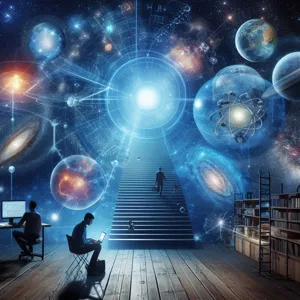
One of the most captivating pieces of evidence supporting the Big Bang Theory is the phenomenon of redshift, which provides a window into the dynamic nature of our universe. As astronomers peer into the depths of space, they observe that light emitted by distant galaxies is shifted toward the red end of the spectrum. This redshift indicates that these galaxies are moving away from us, a discovery that has profound implications for our understanding of the cosmos.
The concept of redshift arises from the Doppler effect, a familiar occurrence that we experience in our daily lives. Just as the sound of a passing ambulance siren changes pitch depending on its movement toward or away from us, light behaves similarly. When an object in space is receding from us, the wavelengths of its emitted light stretch, resulting in a shift toward the red spectrum. Conversely, if an object were moving toward us, its light would shift toward the blue end.
In the early 20th century, astronomer Edwin Hubble made a groundbreaking observation: the further away a galaxy is, the faster it appears to be moving away from us. This relationship, known as Hubble’s Law, suggests not only that the universe is expanding but also that it originated from a singular, hot, and dense state — the Big Bang. The implications are staggering; if the universe is expanding now, it must have been much smaller in the past, leading us to the conclusion that all galaxies were once concentrated in a tiny point.
Furthermore, the measurements of redshift have allowed scientists to map the universe’s expansion rate. This exploration has revealed a vast and ever-growing cosmos, filled with galaxies racing away from each other in a grand cosmic dance. The increasingly red-shifted light from distant galaxies offers a glimpse into the universe’s past and allows researchers to piece together a timeline of cosmic history.
As we continue to study redshift and the expansion of the universe, we deepen our understanding of the fundamental forces at play and the origins of everything we know. This cosmic expansion not only reinforces the Big Bang Theory but also invites us to ponder the vastness of space and the uncharted mysteries that lie beyond our current comprehension.
6. Observational Evidence from Telescopes and Satellites
The grandeur of the cosmos has long fascinated humanity, and telescopes and satellites have become our primary instruments in unraveling its mysteries. The observational evidence supporting the Big Bang Theory is robust and compelling, derived from various groundbreaking discoveries made through these sophisticated tools.
One of the most significant pieces of evidence comes from the Cosmic Microwave Background Radiation (CMBR), a faint glow permeating the universe, which is a remnant of the primordial fireball that existed shortly after the Big Bang. Discovered by the COBE (Cosmic Background Explorer) satellite in the early 1990s, this radiation is almost uniform across the sky, with slight fluctuations that hint at the density variations in the early universe. This discovery not only validated predictions made by the Big Bang Theory but also provided a snapshot of the universe when it was a mere 380,000 years old.
Additionally, the Hubble Space Telescope has played a pivotal role in supporting the Big Bang Theory through its observations of distant galaxies. By measuring the redshift of light from these galaxies, astronomers have confirmed that the universe is expanding, a phenomenon that Edwin Hubble first noted in the 1920s. This redshift indicates that galaxies are moving away from us, suggesting that they were once much closer together—a direct implication of the Big Bang.
Furthermore, satellite observations, such as those from the Planck spacecraft, have provided detailed maps of the CMBR, revealing intricate patterns that correspond to the density fluctuations in the early universe. These patterns allow scientists to understand the formation of large-scale structures, like galaxy clusters, and to refine models of cosmic evolution.
Through these advanced technologies, we have gained profound insights into the universe’s history and composition. The evidence gathered from telescopes and satellites not only reinforces the Big Bang Theory but also inspires awe as we contemplate the origins of our universe, reminding us of our place within its vast tapestry.
7. The Role of Nucleosynthesis in Supporting the Theory
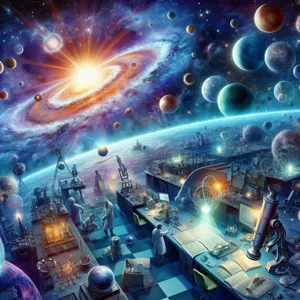
Nucleosynthesis, the process by which new atomic nuclei are formed, plays a pivotal role in providing compelling evidence for the Big Bang Theory. This cosmic phenomenon is particularly noteworthy in the context of primordial nucleosynthesis, which occurred within the first few minutes after the Big Bang. During this brief but crucial period, temperatures soared to astronomical levels, allowing protons and neutrons to collide and fuse, creating the lightest elements in the universe—mainly hydrogen, helium, and trace amounts of lithium and beryllium.
The predictions made by the Big Bang Theory regarding the abundance of these elements have been remarkably accurate. According to theoretical models, about 75% of the universe’s ordinary matter should be hydrogen, while around 25% should be helium. Observations of the cosmic microwave background radiation and the chemical composition of ancient stars and galaxies confirm these proportions, supporting the idea that these elements formed as a direct consequence of the explosive expansion of the universe.
Moreover, the study of nucleosynthesis extends beyond primordial elements. It also encompasses the processes occurring within stars, where heavier elements are forged through stellar nucleosynthesis. This ongoing cycle of element creation and destruction helps us understand not only the origins of the universe but also the evolution of galaxies and the formation of life-sustaining planets.
Thus, nucleosynthesis serves as a bridge between the Big Bang and the present-day universe, linking the initial conditions of cosmic evolution with the rich tapestry of elements that populate our world. The consistency between theoretical predictions and observational data surrounding nucleosynthesis not only bolsters the Big Bang Theory but also deepens our appreciation of the intricate processes that govern the cosmos. In understanding nucleosynthesis, we gain insight into the very fabric of our universe and our place within it, making it an essential piece of the grand cosmic puzzle.
8. Comparing the Big Bang Theory to Other Cosmological Models
When delving into the origins of the universe, the Big Bang Theory stands tall as the prevailing cosmological model, but it is not without competition. Understanding how it compares to other theories allows us to appreciate the nuances and complexities of our universe’s birth.
One notable alternative is the Steady State Theory, which posits that the universe is eternally expanding but maintains a constant average density. Proponents of this model argue that new matter is continuously created to fill the gaps left by the expansion, suggesting a universe that has no beginning or end. However, the discovery of cosmic microwave background radiation and the observable redshift of distant galaxies provided compelling evidence that undercut this theory, favoring the Big Bang perspective.
Another contender is the cyclic model, which proposes that the universe undergoes infinite cycles of expansion and contraction. In this view, the Big Bang is merely one phase in a never-ending series of cosmic evolutions. While this theory offers an interesting take on time and existence, it struggles to explain the current observations of an accelerating universe, which suggests that the expansion is not slowing down but rather speeding up.
Then there’s the concept of a multiverse, where our universe is just one of many bubbles in a vast cosmic foam. This idea raises tantalizing questions about the nature of reality itself but remains primarily theoretical, lacking direct evidence. Proponents of the multiverse suggest that the Big Bang could be a localized event, with other universes existing independently of our own.
As we juxtapose the Big Bang Theory with these alternative models, it becomes evident why it remains the most widely accepted explanation for the universe’s origin. Its alignment with empirical evidence—such as the aforementioned cosmic microwave background radiation and the abundance of light elements—provides a robust framework that others struggle to match. Yet, the exploration of these alternative theories is crucial; they challenge our understanding and push the boundaries of cosmological science.
In essence, comparing the Big Bang Theory to other cosmological models not only highlights its strengths but also illuminates the ongoing quest for knowledge about the universe’s inception. As our observational technology improves and theoretical physics evolves, we may uncover further insights that could reshape our understanding of the cosmos.
9. Implications of the Big Bang Theory on Modern Cosmology
The Big Bang Theory is not just a historical narrative of the universe’s inception; it serves as a foundational pillar for modern cosmology, influencing our understanding of the cosmos in profound ways. At its core, the theory posits that the universe began as an infinitely dense point around 13.8 billion years ago, rapidly expanding and cooling to form the vast and complex cosmos we observe today. This explosive birth not only set the stage for the formation of galaxies, stars, and planets but also laid the groundwork for the fundamental laws of physics that govern our universe.
One of the most significant implications of the Big Bang Theory is the concept of cosmic expansion. Edwin Hubble’s observations in the 1920s revealed that galaxies are moving away from us, with those farther away receding faster—a phenomenon now encapsulated in Hubble’s Law. This discovery not only provided strong evidence for the Big Bang but also challenged our understanding of a static universe, suggesting instead that the cosmos is dynamic and ever-evolving.
Moreover, the Big Bang Theory gives credence to the existence of cosmic background radiation—a faint afterglow of the initial explosion. Detected in 1965 by Arno Penzias and Robert Wilson, this microwave radiation permeates the universe and serves as a critical relic of the early universe, providing snapshots of conditions just 380,000 years after the Big Bang. Its uniformity across the sky supports the notion that the universe has expanded uniformly, further solidifying the Big Bang’s central role in cosmology.
In addition to these foundational aspects, the Big Bang Theory also influences our understanding of the universe’s fate. As scientists continue to explore the effects of dark energy—a mysterious force driving the accelerated expansion of the universe—the implications of the Big Bang ripple through discussions about cosmic destiny. Will the universe continue to expand indefinitely, or will it eventually contract in a “Big Crunch”? These questions hinge on the principles established by the Big Bang Theory and continue to ignite curiosity in a field that evolves at the frontier of human knowledge.
In summary, the Big Bang Theory is far more than a singular event; it is a comprehensive framework that shapes our understanding of the universe’s structure, evolution, and ultimate fate. As we delve deeper into the cosmos, the implications of this theory will undoubtedly pave the way for groundbreaking discoveries, reaffirming its place as a cornerstone of modern cosmology.
10. Challenges and Criticisms of the Big Bang Theory
While the Big Bang Theory stands as one of the most widely accepted explanations for the origins of our universe, it is not without its challenges and criticisms. These dissenting perspectives often spring from new discoveries in astrophysics and cosmology, sparking debates that fuel the ever-evolving understanding of our universe.
One of the primary criticisms arises from the theory’s reliance on certain key assumptions, particularly the idea that the universe has always been expanding. Some scientists argue that this assumption may not accurately reflect the complexities of cosmic evolution. For instance, the concept of dark energy, which is hypothesized to drive the accelerated expansion of the universe, remains largely mysterious. Its unclear nature raises questions about the dynamics of cosmic expansion and prompts researchers to explore alternative models.
Another challenge comes from the observations at the cosmic microwave background (CMB) radiation, which serves as a remnant echo of the Big Bang. While the CMB supports the theory, anomalies in its temperature fluctuations have led some researchers to propose alternative cosmological models, such as the cyclic universe theory. This model suggests that the universe undergoes infinite cycles of expansion and contraction, differing fundamentally from the traditional Big Bang narrative.
Moreover, the Big Bang Theory struggles to account for certain large-scale structures observed in the universe. For instance, the existence of vast cosmic voids and the peculiar distribution of galaxies have incited discussions about whether the current model can adequately explain the complexities of cosmic formations.
Finally, there are philosophical implications that complicate the discussion surrounding the Big Bang. Questions about what preceded the Big Bang or what caused it to occur challenge our understanding of time and existence itself. These questions remain largely unanswered, leaving room for speculation and alternative theories.
Despite these challenges, the Big Bang Theory continues to be refined and tested through rigorous scientific research. As new technologies and methodologies emerge, they offer fresh insights into the cosmos, allowing scientists to confront these criticisms and deepen our understanding of the universe’s origins. Ultimately, the dialogue surrounding the Big Bang Theory is a testament to the dynamic nature of science, where questioning and exploration lead the way toward greater knowledge and discovery.
11. The Influence of the Big Bang on Our Understanding of Time
The Big Bang Theory is not just a profound explanation of the universe’s origins; it also reshapes our understanding of time itself. Before this groundbreaking theory emerged in the early 20th century, time was often viewed as a constant, an unchanging backdrop against which events unfolded. However, the Big Bang introduces a dynamic perspective: time is intrinsically linked to the very fabric of the universe.
According to the Big Bang model, time began with the creation of the universe approximately 13.8 billion years ago. This moment marked the beginning of not just space and matter but also time as we know it. The implications of this are staggering—time is not an infinite continuum that existed before the cosmos, but rather a dimension that emerged at the very instant of the Big Bang.
Moreover, the expansion of the universe, a key feature of the Big Bang Theory, further complicates our perception of time. As galaxies move away from each other, it becomes evident that time flows differently depending on the observer’s position and velocity. This leads to the fascinating concept of time dilation, where time can appear to pass at different rates depending on gravitational forces or relative speeds—ideas that challenge our intuitive understanding of time as a uniform experience.
The Big Bang has propelled physicists and cosmologists to reconsider fundamental questions about existence: What does it mean for time to have a beginning? What implications does this have for concepts like causality and entropy? As researchers continue to explore these questions, the Big Bang Theory remains central not only to our understanding of the universe’s history but also to the intricate tapestry of time itself. In this sense, the Big Bang is not merely a historical event; it is a pivotal moment that invites us to ponder the very nature of reality and our place within it.
12. Future Research and Discoveries in Cosmology
As we stand on the precipice of a new era in cosmological research, the future promises to unravel even deeper mysteries of the universe. The Big Bang theory, while a robust framework for understanding the origins of our cosmos, is not without its questions and uncertainties. This is where future research comes into play, armed with cutting-edge technology and innovative methodologies that will enhance our understanding of cosmic phenomena.
Upcoming space missions, such as the James Webb Space Telescope, are set to revolutionize our observations of the universe. With its ability to peer into the distant cosmos, Webb will explore the formation of the first galaxies, stars, and planetary systems, delving into the conditions present just moments after the Big Bang. The data collected could provide insight into dark matter and dark energy, two enigmatic components that constitute a significant portion of the universe yet remain largely mysterious.
Furthermore, ground-based observatories are gearing up for heightened observational campaigns, utilizing advanced techniques like gravitational wave astronomy. These ripples in spacetime, first detected in 2015, hold the potential to reveal details about the most violent cosmic events—such as colliding black holes and neutron stars—offering a new lens through which to examine the universe’s evolution.
In addition to observational advancements, theoretical research plays a crucial role. Physicists are exploring concepts such as inflationary theory, which seeks to explain the uniformity of the cosmos and its large-scale structure. New models are being proposed to address questions about the very nature of time, space, and the ultimate fate of the universe.
Collaboration across disciplines is also on the rise, as scientists from fields such as particle physics, quantum mechanics, and even philosophy bring diverse perspectives to cosmological questions. This interdisciplinary approach is crucial for tackling the profound implications of our findings and pushing the boundaries of human knowledge.
As we look ahead, the journey into the cosmos is only beginning. With each new discovery, we not only refine our understanding of the Big Bang but also confront the profound questions about existence itself—what lies beyond the observable universe, and are we alone in this vast expanse? The answers may be closer than we think, waiting to be unveiled by the inquisitive minds of future generations.
13. How the Big Bang Theory Affects Our View of Existence
The Big Bang Theory is not just a scientific explanation for the origin of the universe; it fundamentally reshapes our understanding of existence itself. At its core, this theory posits that the universe began as an infinitely dense point approximately 13.8 billion years ago, rapidly expanding into the vast cosmos we observe today. This explosive inception prompts profound philosophical and existential questions about our place in the universe and the nature of reality.
Understanding that the universe had a beginning challenges the notion of a static, eternal cosmos. Instead, we grapple with the idea that everything—the stars, planets, and even time itself—was birthed from a singular event. This revelation can evoke a sense of awe and insignificance, making us realize that we are mere specks in an ever-expanding expanse. Yet, it also offers a sense of connection; we are all composed of the remnants of that primordial explosion, our very existence intertwined with the fabric of the universe.
Moreover, the Big Bang Theory encourages us to reconsider our understanding of time. If the universe is continually expanding, then time is not just a linear construct but a dynamic aspect of our reality that is intricately linked to the cosmos itself. This challenges traditional views and invites us to ponder the implications of time on our existence, how we perceive our lives in relation to the universe’s vast timeline, and what it means for our future.
As we delve deeper into the implications of the Big Bang Theory, we find ourselves at the crossroads of science and philosophy. It invites us to explore questions about the origins of life, the possibility of multiple universes, and the ultimate fate of our own. In doing so, it pushes the boundaries of human thought, urging us to seek knowledge beyond the stars while simultaneously reflecting on the profound mystery of our own existence. Understanding the Big Bang Theory is not just an academic pursuit; it is a journey into the essence of what it means to be a part of this grand, ever-unfolding universe.
14. Conclusion: Why the Big Bang Theory Matters
In conclusion, the Big Bang Theory stands as one of the most significant scientific frameworks for understanding our universe’s origins and evolution. Its importance extends far beyond a mere explanation of cosmic beginnings; it reshapes our perception of time, space, and our place within the grand tapestry of existence. By postulating that the universe is not static but rather dynamic and ever-expanding, the theory challenges us to rethink fundamental concepts about reality.
The evidence supporting the Big Bang—ranging from the cosmic microwave background radiation to the observable redshift of distant galaxies—has not only deepened our understanding of cosmic history but has also sparked profound philosophical inquiries. It raises questions about the nature of existence, the potential for other universes, and the ultimate fate of our own. Moreover, the Big Bang Theory serves as a unifying framework for countless astronomical observations, linking the realms of physics and cosmology in a compelling narrative of creation and destruction.
Understanding the Big Bang Theory is not just for scientists or enthusiasts; it is an essential part of our cultural and intellectual heritage. It invites us to explore the mysteries of the universe, igniting curiosity and inspiring future generations of thinkers and innovators. As we continue to probe the cosmos and unravel its complexities, the Big Bang Theory will remain a cornerstone of our quest for knowledge—reminding us that we are all part of an extraordinary story that began billions of years ago and continues to unfold.
15. Resources for Further Exploration of Cosmology
As you embark on your journey to delve deeper into the fascinating realm of cosmology, a treasure trove of resources awaits to enhance your understanding of the universe and the compelling evidence behind the Big Bang Theory. Whether you are a curious novice or a seasoned enthusiast, these materials will enrich your knowledge and spark your imagination.
**Books:**
Start with some of the cornerstone texts in cosmology. “A Brief History of Time” by Stephen Hawking offers an accessible yet profound insight into the universe’s origins, black holes, and the nature of time itself. For a more contemporary perspective, consider “Astrophysics for People in a Hurry” by Neil deGrasse Tyson, which distills complex concepts into digestible bites, making it perfect for those on the go. “The First Three Minutes” by Steven Weinberg is another classic that details the first moments of the universe and provides an in-depth understanding of particle physics and cosmology.
**Documentaries and Series:**
Visual learners will find documentaries like “The Universe” series on the History Channel or “Cosmos: A Spacetime Odyssey” hosted by Neil deGrasse Tyson to be truly enlightening. These series not only present engaging visuals of the cosmos but also break down scientific concepts into relatable narratives that captivate the viewer’s imagination.
**Podcasts:**
For those who prefer auditory learning, numerous podcasts delve into cosmological topics. “StartUp Podcast” by Gimlet Media includes episodes discussing scientific startups making strides in cosmology. “Orbital Path” from PBS explores the mysteries of space and scientific phenomena, making it an excellent companion for your daily commute or workout.
**Online Courses:**
Platforms like Coursera and edX offer online courses from top universities, enabling you to learn from the experts. Courses such as “The Big Bang” from the University of Virginia or “Introduction to Astronomy” from the University of Arizona provide structured learning experiences with interactive components.
**Websites and Forums:**
Engage with communities and stay updated with the latest research by exploring websites like NASA’s official site, which features articles, educational resources, and stunning images of space. Online forums like Reddit’s r/space or r/askscience allow you to connect with fellow enthusiasts, ask questions, and participate in discussions on a wide array of topics related to cosmology.
With these resources at your fingertips, you’ll be well-equipped to explore the vastness of the universe and the fascinating evidence that underpins the Big Bang Theory. Whether you’re gazing at the stars or diving into research papers, the cosmos is waiting to unveil its secrets to you.
In conclusion, our exploration of the Big Bang Theory has revealed not only its scientific significance but also the profound implications it holds for our understanding of the universe. From cosmic microwave background radiation to the observable expansion of galaxies, the compelling evidence presented throughout this post underscores the theory’s credibility and its pivotal role in modern cosmology. As we continue to unveil the mysteries of the cosmos, the Big Bang Theory stands as a testament to human curiosity and the relentless pursuit of knowledge. We encourage you to delve deeper into this fascinating subject, as each discovery brings us closer to understanding our place in the vast universe. Thank you for joining us on this journey through time and space—stay curious, and keep looking up!

